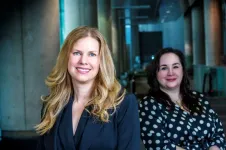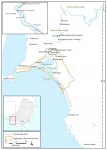(Press-News.org) A global review of coastal drowning science has found there is only one study worldwide that has evaluated beach safety education programs in schools.
Researchers from UNSW's Beach Safety Research Group have conducted the first in-depth review specific to coastal drowning.
The study, published in PLOS ONE, reviewed 146 coastal drowning studies from around the world.
"We found that evaluation of coastal drowning prevention strategies is rare," said William Koon, the lead author of the study and a PhD candidate in the School of Biological, Earth and Environmental Sciences said.
"This means we simply don't have enough data showing what works and what doesn't work.
"There was only one study worldwide - involving a private primary school in Queensland - to see if beach safety education program is effective in schools."
Since the review, an additional school-based evaluation of water safety virtual reality programs in Victoria has been published.
Mr Koon said the review's findings are concerning as tens of thousands of Australian primary and secondary school students participate in beach or water safety programs from lifeguards and lifesavers every year.
"There is remarkably little information out there to say [firstly], does it work and [secondly], here's how it works best," Mr Koon said.
"We need to assess if programs function as intended, and continually refine them to improve effectiveness."
Researchers and UNSW Beach Safety Research Group founding members Dr Amy Peden, Dr Jaz Lawes and Professor Rob Brander were also involved in the study.
"I find it interesting that over the last 16 years we haven't really seen any improvement in the number of coastal drownings each year in Australia, despite lots of ongoing school and public education programs," Professor Brander said.
The study found that more than three-quarters (76.7%) of coastal drowning research was from high-income countries. Australia is leading the way with 49 studies, followed by the US (28 studies).
It also found that existing drowning prevention strategies are largely un-evaluated, with little research being done in low-income countries where a majority of drowning events occur.
Mr Koon said while there were 125 coastal drowning deaths in Australia last year, the World Health Organisation estimates that more than 90 percent of all drowning occurs in low-and middle-income countries.
He said to address this global health problem, researchers need to start looking to local data from lower-resourced settings to understand the coastal safety issues there and prioritise drowning prevention programs for different groups of people.
"Researchers like myself need to ask 'is what I learned from Australian coastal safety research applicable to a place like Ghana or Costa Rica or India, where similar hazards exist, but the cultural context is very different'," he said.
The researchers conducted the review to better understand the science driving safety initiatives and highlight gaps in the field of coastal drowning, in order to prioritise future studies and prevention initiatives that will ultimately save lives.
They focused on fatal unintentional coastal drowning that was unrelated to boating, disaster (ie cyclones) or occupational accidents (ie commercial fishermen or scuba divers).
They found studies inconsistently reported intentional, occupational and boating coastal drowning deaths, and the terminology used to describe coastal waters was also non-uniform.
"Reviews such as this one are so important as they highlight gaps in the current evidence base, identifying opportunities for future research to really make a difference, rather than more of the same," study co-author Dr Amy Peden, from the UNSW School of Population Health said.
Over 100 different risk factors related to coastal drowning were identified, but the data sources, outcomes used, and analyses employed were variable.
"What we learned is that the consistency in reporting and analysing of these different scenarios was just all over the place," Mr Koon said. "Not every place in the world is recording drowning in the same way.
Studies were also published in a variety of journals representing different disciplines.
Many studies recommended prevention measures, most frequently related to education, lifeguards and signage.?
"Is that enough? Are these efforts working? How well? We don't have enough data to answer these questions," Mr Koon said.
There are limited resources for evaluations on water safety programs, he said.
"But someone with a long-term view should start to see that investment in monitoring and evaluation is a way to really make sure the work is doing what it's supposed to do," he said.
He says it is important to continue to refine school water safety programs.
"There are probably different lessons to be learned, such as messaging at different ages, whether that's stopping to look for rips or putting on sunscreen, avoiding alcohol or avoiding jumping off rocks and cliffs.
He said there has been "remarkably little information" studying prevention measures.
"Research on danger signs on beaches has already told us that people don't really look at signs, and if they do, are not really influenced to change decisions or behaviour," he said.
"We're still in the stage where most programs are driven by expert opinion without much supporting data."
He said Australia continues to lead the world in drowning prevention and water safety research because organisations like Surf Life Saving Australia and Royal Life Saving Society - Australia maintain robust databases, with some of the most detailed drowning data in the world.
UNSW Beach Safety Research Group researchers are currently working with Lake Macquarie lifeguards to evaluate a beach safety program which they deliver to high school students.
"We hope to be able to offer some recommendations on how other people in the industry can move forward with evaluating some of their school and other beach safety education programs," he said.
"As our review has shown, the kind of information this evaluation will yield addresses a massive gap in our understanding of what's effective and what's not in the drowning prevention education space," Dr Peden said.
"Identifying what can improving safety and reduce young people's risk of drowning during adolescence can result in positive behaviours throughout adulthood."
INFORMATION:
Read the study in PLOS ONE.
The National Science Foundation (NSF) selected an NYU Tandon School of Engineering professor who is developing new approaches to training deep learning (DL) artificial intelligence frameworks, to receive its most prestigious award for promising young academics.
Anna Choromanska, an assistant professor in the Department of Electrical and Computer Engineering (ECE), received a 2021 NSF Faculty Early Career Development Award, more widely known as a CAREER Award, which supports early-career faculty who have the potential to serve as academic role models in research and education.
A five-year, $532,892 grant will support a project that focuses on new, more efficient ways of training ...
The continuous improvement of imaging technology holds great promise in areas where visual detection is necessary, such as with cancer screening. Three-dimensional imaging in particular has become popular because it provides a more complete picture of the target object and its context.
"More doctors and radiologists are looking at these 3D volumes, which are new technologies that allow you to look not just at one image, but a set of images," said UC Santa Barbara psychology professor Miguel Eckstein(link is external), whose expertise lies in the field of visual search. "In some imaging modalities this gives doctors information about volume and it allows them to segment what they're interested in."
Common wisdom is that with all ...
Bring on Twilight. Lee Child's Jack Reacher? Yes, please. More of James Patterson's Alex Cross while we're at it. And let's finish off with revisiting the million-plus words of the Harry Potter saga.
No one will confuse the above book series with high literature. But a new study published in the journal Reading and Writing shows that the more people read any kind of fiction -- even mass market stuff sniffily derided as pulp -- the better their language skills are likely to be.
The piece was written by Sandra Martin-Chang, professor of education in the Faculty of Arts and Science, and PhD student Stephanie Kozak. They found that people who enjoyed reading fiction for leisure and who identified as a reader scored higher on language tests, whereas ...
It's not uncommon for crescent-shaped swaths of sand to dot the shorelines of meandering rivers. These swaths usually appear along the inner side of a river bend, where the bank wraps around the sandy patch, forming deposits known as a "point bars."
When they appear along an outer bank, which curves the opposite way, they form "counter-point" bars, which are usually interpreted by geoscientists as an anomaly: a sign that something - such as a patch of erosion-resistant rocks - is interfering with the river's usual manner of sediment deposition.
But according to research led by The University of Texas at Austin, counter-point bars are not the oddities they're often ...
PHILADELPHIA (March 16, 20201) - After a traumatic injury, returning to work (RTW) can be a strong indication of healing and rehabilitation and may play a pivotal role in promoting physical and functional recovery. But how does RTW after a traumatic injury affect mental health recovery, particularly in individuals who experience social and economic marginalization?
In a new study from the University of Pennsylvania School of Nursing (Penn Nursing), researchers investigated the ways that RTW after an injury predict mental health outcomes in Black men living and recovering in Philadelphia. The study found that men ...
AI has, for some time, been applied to diagnose medical conditions in specific fields. It can build on knowledge of particular disciplines to hone in on details such as the shape of a tumor that suggests breast cancer or abnormal cells that indicate cervical cancer. While AI is very good when trained on years of human data in specific domains, it has not been able to deal with the huge number of diagnostic tests (about 5000) and disorders (about 14,000) of modern clinical practice. Now, a new algorithm developed by engineers at the USC Viterbi School of Engineering can think and learn just like a doctor but with essentially infinite experience.
The work comes out of the lab of Gerald Loeb, a professor ...
BOSTON - In addition to lowering risk of heart disease, maintaining a heart-healthy lifestyle may pay off in lower risk for developing cancer, researchers from Massachusetts General Hospital (MGH) and other centers in the United States and the Netherlands have found.
Looking at the potential link between cardiovascular disease (CVD) and cancer among participants in two large population-based health studies, Emily S. Lau, MD, and Jennifer E. Ho, MD, from the division of Cardiology at MGH and their co-authors found that traditional risk factors for CVD, including older age, male ...
The discovery of a rare bone artefact near the Lower Murray River casts more light on the rich archaeological record on Ngarrindjeri country in southern Australia.
Details of the Murrawong bone point, dated between c. 5,300-3,800 years old, has have been described by Flinders University, Griffith University and other experts in a new paper in Australian Archaeology.
Probably made from a macropod (kangaroo or wallaby) bone, the point was likely used for piercing soft materials - for example, used as a pin on a cloak made of possum furs - or possibly as a projectile point, say the research leaders ...
Vision impairment is a pervasive problem facing nearly 2.2 billion people globally, according to the World Health Organization. But help is on the way: Neuroscientists are working at the cutting edge of technology and brain science to develop new ways for the vision impaired to navigate the world around them. At the annual meeting of the Cognitive Neuroscience Society (CNS), researchers are presenting new techniques for integrating digital haptics and sound technology to transform vision rehabilitation for both children and adults alike.
"Vision rehabilitation requires bridging fundamental research, modelling and neuroimaging methods," ...
FAIRFAX, Va. (March 16, 2021)--Many women suffering significant postpartum bleeding continue to receive hysterectomies, rather than uterine artery embolization (UAE), despite evidence that UAE results in reduced hospital stays and costs, and offers an opportunity to preserve fertility, according to new research to be presented at the Society of Interventional Radiology Annual Scientific Meeting.
"Giving birth has become increasingly dangerous for women in the U.S., and postpartum hemorrhage is a leading cause of the loss of life related to childbirth," said Janice M. Newsome, MD, FSIR, associate professor, Department of Radiology and Imaging ...


